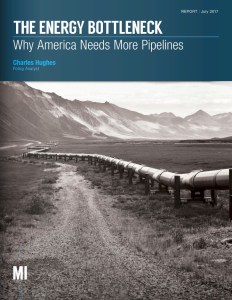 A new report by the Manhattan Institute says that to maximize the benefits of America’s energy renaissance, the Trump administration, Congress, and federal and state regulators should prioritize expanding and upgrading the country’s inadequate pipeline infrastructure.
A new report by the Manhattan Institute says that to maximize the benefits of America’s energy renaissance, the Trump administration, Congress, and federal and state regulators should prioritize expanding and upgrading the country’s inadequate pipeline infrastructure.
Economist Charles Hughes is the author of a new report, The Energy Bottleneck: Why America Needs More Pipelines. He writes that a more robust pipeline infrastructure would make transportation of oil, natural gas and their products more efficient by reducing transportation costs and offering a more reliable mode of transportation. A well-developed energy transportation network would also reduce regional price differences.
“America is enjoying an energy renaissance, as U.S. firms produce vast amounts of oil and natural gas that need to be shipped safely and efficiently across the country and abroad. Pipelines offer the best way to achieve this. Yet the supply of pipelines is not keeping pace with demand. The result: a growing energy bottleneck that is forcing oil and gas companies to turn increasingly to more accident-prone and more expensive shipping alternatives, such as trucks, railroads, and tankers.”
The report’s key findings include:
- Average annual accident rates during 2007–16, per billion ton-miles of oil and gas transported, were 0.66 for oil pipelines (i.e., the fewest accidents), 0.73 for natural gas pipelines, 2.20 for rail, and 7.11 for road.
- During the same period, annual property damage caused by pipelines ($352.89 million) was only about 0.002%—or two one-thousandths of 1%—of U.S. GDP in 2016 ($18.46 trillion).
- To maximize the benefits of America’s energy renaissance, the Trump administration, Congress, and federal and state regulators should prioritize expanding and upgrading the country’s inadequate pipeline infrastructure.
Read the full Manhattan Institute report here.
